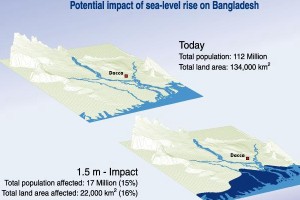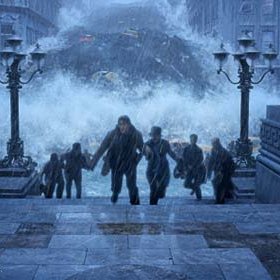|
|
 |
Are we threatened by the ocean?
Flood waves over New York, standstill of the North Atlantic Ocean stream, sea level rise. How menacing are the oceans?
|
|
The waterways have always been important for cultural exchange and trading between the people. Nearly all towns are located next to the coast or to rivers and 60% of the worlds population lives no further than 100 km from the sea. Therefore, a strong rise of the sea level is rather menacing. Projections until the end of the century predict a 9-88 cm rise; 50 cm is regarded as a good estimation.
|
 |
 |
|
How much land will be flooded if sea level rises by 1.5 m in Bangladesh?
Please click on the image for a larger view!
Source: UNEP GRID
|
|
 |
For the wealthy countries on our planet a 1 m sea level rise is a challenge, however it can be managed. For densely populated, flat and poor coastal countries like Bangladesh this is a catastrophic perspective. Even more so because sea levels will continue to rise over the next centuries. Poor countries, located next to the coast, will loose a lot of their area. As well as this, some of the holiday paradises will slowly sink. Many coral reefs, which are regarded as the rain forests of the sea with their fantastic biodiversity, will disappear. Venice may give Piazza San Marco back to the sea or the town will have to be protected behind dykes.
|
|
Mankind will have some trouble with the oceans. However, what overruns New York and makes people run for their life is a giant wave. This is neither anything to do with climate change nor would it be typical for a storm surge. Waves of such dimension, up to 30 m of altitude, have been created in rare cases following a seaquake. They are called tsunami. Earth- or seaquakes, like volcanic eruptions, have their origins in the tectonic shifts of the Earth's continental plates and processes going on in the inner Earth. Humans and the climate do not have any influence here.
|
 |
 |
|
Film phantasy: a giant wave overruns New York.
© 20th Century Fox
|
|
 |
 |
 |
|
Real catastrophy 1946 at Hawaii. People run for their lives as tsunami waves approach after a seaquake. The climate is not responsible.
© Pacific Tsunami Museum
|
|
|
Ocean currents
The oceans influence the climate system and our living conditions in many ways: the giant circulation of water masses help to transport heat from the tropics to the poles and thus define climate zones. A heating of the oceans causes its expansion and consequently the danger of floodings due to sea level rise or of storm surges.
|
 |
 |
|
Ocean currents transport warm and cold water masses round the Earth, on the surface (red) as well as in the deep sea (blue and violet). At the points marked with yellow dots deep water is formed. The North Atlantic is an important engine in this.
Source: Stefan Rahmstorf, Nature 2002
|
|
The ocean currents are driven by two 'engines': the first is the big wind systems of Earth (for example the trade winds). The second is differences in water density. Cold water is denser than warm water and sinks. Equally, salty water is denser than less salty water. For Europe and North America the currents in the North Atlantic are very important. The Gulf Stream and its branch, the North Atlantic Stream, convey warm water towards the north. The air warms up above the water and we benefit from mild westerly winds. This is why the winter in Hamburg or Glasgow is much milder than in Moscow. Disruptions in these ocean currents can drastically change our climate, as described in the next section.
Next page
|
|
 |
|







